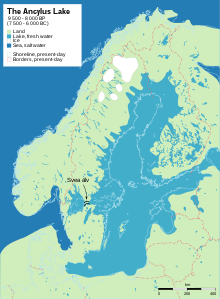Maglemose culture
|
||||||||
| expansion | ||||||||
|---|---|---|---|---|---|---|---|---|
| Northern European lowlands | ||||||||
|
||||||||
| Leitforms | ||||||||
|
The Maglemose culture (around 9000 to 6500 BC) is the oldest Mesolithic culture of the northern European lowlands. The term was introduced in 1912 by the Danish archaeologist Georg L. Sarauw (1862-1928) after the archaeological excavations carried out since 1900 in the marshland Magle Mose (Danish: 'Great Moor') near Mullerup on the west coast of Zealand ( Denmark ) .
This culture was common in England , northern Germany , Denmark, southern Sweden and the Baltic States ( Kunda culture ). The Danish Gudenå culture has proven to be a conglomerate consisting of several cultural layers and is no longer regarded as a culture in its own right by the more recent archeology literature.
Climate and vegetation
After the stage of the younger Dryas period at the end of the last glacial period ( Vistula glacial period ), it became from about 9650 BC. Very quickly warmer. As a result of the associated melting of the glaciers, a meltwater lake formed in the southern area of today's Baltic Sea , which was initially separated from the ocean by a mainland bridge between Scandinavia and mainland Europe. In presumably multiple alternations between the rise and overflow of this freshwater lake and the rise of the world's oceans, the brackish water of the Yoldia Sea soon formed through the influx of seawater . Scandinavia, freed from the ice load, then rose so far that the Yoldia Sea was separated again and sweetened to become the Ancylus Sea . The whole thing was repeated: first brief overflows into the Kattegat , then between 7000 and 5600 BC. Chr. Ever stronger influx of sea water and the formation of the Littorina Sea . With rising sea levels, the coastal plains and floodplains of the glacial valleys were flooded, together with the previous resting and living areas of the Maglemose people. In the North Sea, Doggerland sank in the floods around the end of this culture.
The north of what is now East Germany, Mecklenburg and Pomerania, was probably only sparsely populated at that time, because these regions were oversaturated with meltwater from the glaciers and were therefore extremely swampy. Today's lake plateaus and peat areas as well as the gigantic aquifers under East Germany are a legacy of the Ice Age and keep the North German Plain fertile.
The open tundra landscape of the preboreal has been replaced in the boreal by forests and dense vegetation. First birch and pines became indigenous, the hazelnut, mixed deciduous forests followed, mainly elm and linden, later mixed oak forests grew. The Ice Age fauna of the tundras with migrating herds of reindeer and wild horses migrated to the north and east. Deer , wild boar , wolf and bear now lived in the woods .
Dwelling places and graves
The main source of food for the people was still hunting and more often fishing (especially the pike was popular) as well as the gathering of berries, nuts and wild fruits. The people settled down at least seasonally and built huts, like those discovered at Howick in Northumberland or on Nivå 10 on the Little Belt. A phenomenon that occurred around 6500 BC. The Congemose culture , which began in BC, and the subsequent Ertebølle culture are the Køkkenmøddinger , large clam heaps with various remains of living quarters, along the former Baltic coast.
Individual and collective burials were common; the bodies were buried in a stool position (also as a sitting stool) and often sprinkled with red chalk. The oldest bog body in Denmark, the " Man from Koelbjerg ", also dates back to the Maglemose culture. His death is rated as an accident.
Material culture
Microlithic flint blades and bone spearheads are typically found . Core, cylinder and disc axes , cross-edged arrowheads and blade scrapers came into use. Inventions of the Maglemose culture were the fish hook and the drill bit .
The oldest evidence of watercraft is a wooden paddle from Star Carr near Scarborough in Yorkshire . Amber was processed into animal figures or jewelry, and human teeth were also worn as jewelry.
literature
- GFL Sarauw (1903): En Stenaldersboplads i Maglemose ved Mullerup - sammenholdt med beslægtede fund. Aarbøger for nordisk Oldkyndighed and history.
- J. Skaarup and Ole Grøn: Møllegabet II - A Submerged Mesolithic Settlement in Southern Denmark.
- Ole Grøn: The Maglemose culture: the reconstruction of the social organization of a Mesolithic culture in Northern Europe. BAR International series 616, Oxford 1995.
Individual evidence
- ↑ Ancylussjön - fortfarande ett mysterium. Havsutsikt 3, 2003, 8-9. and Var gick vattnet , Arkeologisk Information nr 3, Riksantikvarieämbetet & Östergötlands länsmuseum
